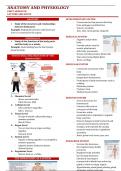ANATOMY AND PHYSIOLOGY
FIRST SEMESTER
LECTURE AND NOTES
ANATOMY INTEGUMENTARY SYSTEM
- Creates barrier that protects the body
• Study of the structure and relationships
from pathogens and fluid loss.
between body parts.
- Sensory reception
Example: Studying the structure of the heart and
- Hair, nails, sweat glands, oil glands
how it is connected to the organs.
SKELETAL SYSTEM
PHYSIOLOGY
- Supports and protects
• Study of the function of the body parts body
and the body as a whole.
- Provide surface area for
Example: Understanding how the heart pumps
muscle attachments
blood the body. - Aids body movements
- Houses cell that produce blood cells
STRUCTURAL ORGANIZATION OF THE - Store mineral and lipids (fats)
HUMAN BODY - Bones, cartilage
MUSCULAR SYSTEM
- Creates the movement of the
body
- Contributes to body
temperature homeostasis
- Participates in body movements such as
walking
- Maintains posture
- Produces heat
- Skeletal muscle, tendon
1. Chemical Level
NERVOUS SYSTEM
- Atoms and molecules
- Acts as the sensor for
- DNA, Glucose, RNA
homeostasis
2. Cellular Level
- Connects the brain to
- Cells and their organelles
every part of the body
- RBC’s, Neurons
- Generates action
3. Tissue Level
potentials (nerve impulses) to regulate
- Groups of similar cells performing a
body activities
common position.
- Detects changes in body’s internal and
- Muscle Tissue
external environments, interprets
4. Organ Level
changes, and responds by causing
- Two or more tissue types working
muscular contractions or glandular
together.
secretions
- Stomach, brain
- Brain, spinal cord, nerves, eyes, ears
5. System Level
- Organs working together to accomplish a
ENDOCRINE SYSTEM
common purpose.
- Secretes the hormones
- Digestive System, Endocrine System,
that regulate many bodily
Skeletal System
processes
6. Organisms Level
- Regulates body activities
- Human body as a whole.
by releasing hormones
THE HUMAN BODY AS A SYSTEM (chemical messengers
transported in blood from endocrine
gland or tissue to target organ).
- Hypothalamus, pineal gland, pituitary gland,
hormones, ovaries, pancreas
, ANATOMY AND PHYSIOLOGY
FIRST SEMESTER
LECTURE AND NOTES
- Delivers oxygen, - Helps maintain the acid-base balance of
nutrients, hormones, and body fluid
waste products - Kidney, ureter, urinary bladder, urethra
throughout the body
- Blood, heart, blood vessels REPRODUCTIVE SYSTEM
- Gonads also release hormones that
LYMPHATIC SYSTEM regulate reproduction and other body
- Regulates fluid processes
balance in the body - Produce and
- Houses some of the exchange gametes
immune cells that - House the fetus and
depend the body birth
from pathogens - Lactation
- Returns proteins and fluid to blood - Ovary, testis, vagina, penis
- Carries lipids from gastrointestinal tract to
blood MAINTAINING BOUNDARIES
- Contains sites of maturation and - To remain the inside distinct from
proliferation of B cells and T cells that the outside.
protect against disease-causing microbes
- Lymph nodes, lymph vessels, thymus, spleen NECESSARY LIFE FUNCTIONS
1. Metabolism
RESPIRATORY SYSTEM - Sum of all chemical processes that occur
- Exchanges air with the in the body.
atmosphere - All chemical reactions in the body
- Provides surface area for - Catabolism, Anabolism
the diffusion of oxygen - Includes breaking down complex
and carbon dioxide with substances into simpler building blocks,
blood making larger structures from smaller
- Helps regulate acid-base ones and using nutrients and oxygen to
balance of fluids produce molecules of ATP
- Air flowing out of lungs through vocal - Depends on Digestive, Respiratory, and
cords produce sounds Cardiovascular System
- Lungs, airways, trachea, bronchus, larynx, - Regulated chiefly by hormones secreted
pharynx by gland of Endocrine System
2. Responsiveness
DIGESTIVE SYSTEM - Irritability
- Breaks down food and - Body’s ability to detect and respond to
absorbs nutrients into the changes
body - Ability to sense and respond to stimuli
- Eliminates solid wastes 3. Digestion
- Achieves physical and - Breaking down of undigested food into
chemical breakdown of simple molecules that can be absorbed by
food blood
- Mouth, pharynx, esophagus, stomach, - Nutrient-rich blood is then distributed to
intestines, anus all body cells by the cardiovascular
system
URINARY SYSTEM 4. Excretion
- Contributes to blood - Removing of excreta or wastes from the
pressure and pH body, non-useful substances produced
homeostasis during digestion and metabolism must get
- Removes waste products rid thru digestive and urinary system
from the body 5. Movement
- Produces, stores, and - Motion of the whole body, individual




